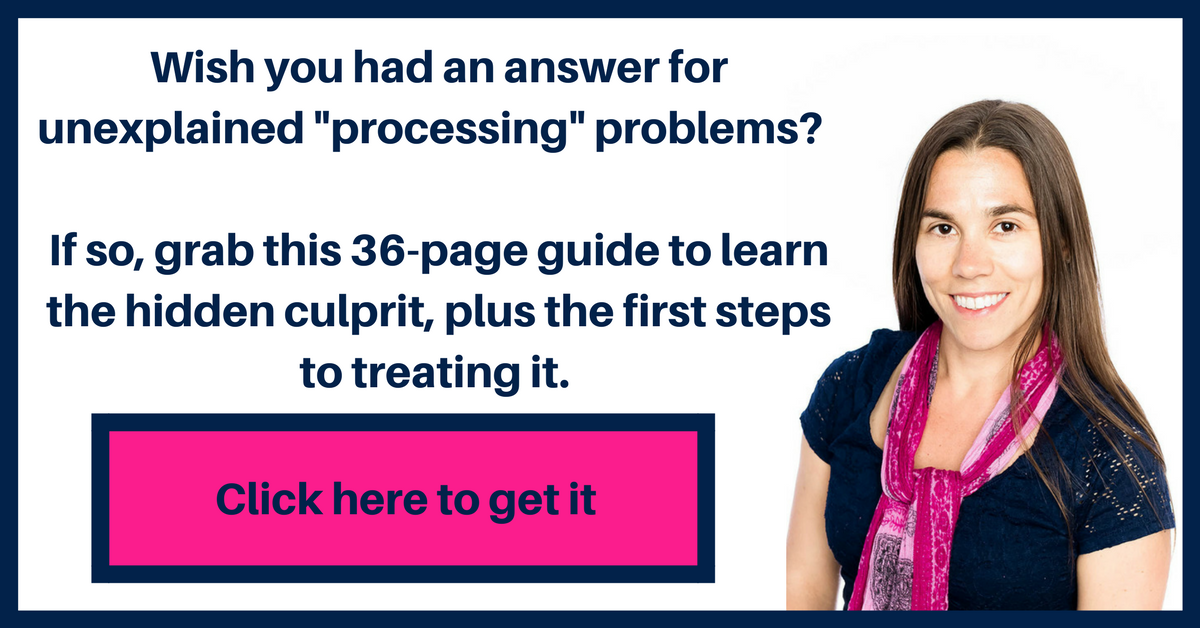Do you spend loads of time working on “main idea” and “supporting details”?
We all know these skills are important.
I mean, stating the main idea and supporting details is expected according to the Common Core Standards.
Students have to be able to do it to succeed in school.
After all, getting the “gist” and understanding what happened when you listened to or read something is the whole point, right?
But what if I told that direct comprehension work might now be what your students need?
Why do I say this?
Well, the answer is a bit complicated.
It’s not that we shouldn’t EVER work on main idea and supporting details or other general comprehension strategies. Many times, we should.
Rather, its that we might need to do other things FIRST before these strategies are even helpful.
Ever heard the mantra, “Treat the cause, not the symptom”?
That applies here.
Common sense would tell us that if a student can’t name the main idea or supporting details, we should spend therapy time asking them to practice naming main idea and supporting details.
But really, we need to think about why they can’t comprehend in the first place.
This was the debate I faced with my student, John, who I’ve described in my most recent article. John was bombing reading comprehension tests, and he also did poorly on the Listening Comprehension Test-2 (Bowers, Huisingh, LoGuidice, 2006).
The problem was that I’d already been working on these skills for years without seeing any measurable improvements.
Yet things became clearer when I found that he also showed deficits in semantics and syntax.
It was a chicken or egg debate. Did he have poor language skills because he wasn’t comprehending, or was he not comprehending because he had poor language skills?
According to Scott (2009), the weak syntactic skills may have been the root issue.
In Scott’s article, A case for the sentence in reading comprehension, she explained that the cause of general comprehension problems may be underlying semantic and syntactic difficulties.
In other words, if students don’t understand the sentences, they aren’t likely to understand the main idea of an entire paragraph.
So while we give out well-meaning advice such as, “Read to your kids and ask them questions,” that might not be enough in some cases.
While I won’t argue against this advice, I will insist that some kids need something more specific and targeted.
This would include the students with language impairments on our caseloads.
If we don’t address underlying deficits in lexical and syntactic knowledge, students may not be capable of benefiting from general comprehension strategies focused on main idea and supporting details (Gillon & Dodd, 1995).
Yet many interventions for students with “processing” and “comprehension” difficulties skim over the root causes (e.g, weak sentence comprehension) and head right towards treating the symptoms (e.g., retelling the main idea and supporting details).
Let’s back up and think about a “non-speech” example as an analogy.
The last few years, my husband and I have really focused on getting my stepdaughter, Olivia, to be a better swimmer.
Ultimately, we wanted her to be able to keep her head above water and make forward progress in water over her head. But at a certain point in time, she couldn’t do it.
The “symptom” of the problem was that her head would go under water and she would start to sink until we pulled her out.
To fix the “problem” we didn’t just throw her off the deep end and practice these skills right away, because she wouldn’t have known what to do.
She would have either drowned, or would have needed one of us to jump in and pull her to the edge.
So what did we do?
We gave Olivia explicit practice in all of the skills needed to make forward progress in water over her head.
She learned what to do with her arms. She learned how to position her body and how to move her legs.
Eventually she had the basics.
Only then could we let her go in to the deep end and practice.
And when we did, we did a little bit at a time until she could make it all the way across the pool; just like our therapy should increase in difficulty over time.
Here she is the first week we let her go off the diving board.
Now here she is two years later (in the pink suit in the far lane). She got there by practicing swimming in the deep end, but she wouldn’t have benefited from that practice without having the foundation in place first.
Without the basics, we would have been repeatedly setting her up for failure.
Lets say that stating the main idea and supporting details of a text is like swimming in the deep end.
Kicking, body position, and moving your arms is like the semantic/syntactic knowledge you need to understand sentences.
If you keep asking a student to state the main idea and supporting details of entire texts, paragraphs, and lengthy discussions without helping them comprehend sentences FIRST, you may just be throwing them off the deep end and letting them drown.
So what does this mean for us as SLPs?
Essentially it comes to down understanding what’s involved in “comprehension”.
When it comes to reading comprehension, Scott (2009) challenged our narrow view, and instead suggested that sentence comprehension plays a significant role in text-level comprehension.
As Scott accurately explained, sentence comprehension is often the culprit for students with language impairments.
We need to understand the meaning of a sentence in order to get meaning from the text as a whole.
This presents a significant problem for children with SLI who have a poor sense of language structure, and who are required to “read-to-learn” in late elementary on through secondary school.
When we look at longitudinal research, we see that children with poor language skills in early elementary school are often the poor readers in high school (Nippold, 2017).
We also see the same trend when we go in the other direction; so students who have been identified as “poor comprehenders” also have lower scores on oral sentence-level semantic/syntactic tasks (Scott, 2009).
Scott’s discussion about sentence comprehension shed some light on the issues I was having with John, my student who didn’t improve after several years of working solely on main idea and supporting details.
You can read more about John’s story in this article here.
Jonn’s problems stemmed from the fact that no one was targeting morphology, syntax, or semantics in a way that he truly needed.
In the end, I realized that it made sense for me, as the SLP and language expert, to focus on those areas that impacted sentence comprehension (for both John and others like him).
So when I say that it “might” be a poor choice to spend tons of therapy time working on main idea versus details, it’s not because those skills aren’t important.
It’s because we only have so much time with our students, and we need to make it count. Which means we need to focus on the root cause of the problem, rather than the symptom.
Don’t get me wrong: I’m not saying that it’s NEVER appropriate for you to work on general comprehension.
There are times that students will need you to help them with tasks that require them to apply multiple linguistic skills at once; and moving on to more functional tasks may be a critical piece to their success.
Yet for students with underlying sentence comprehension deficits, our therapy time may be best spent working on syntax and vocabulary FIRST.
So the question now is how to do that effectively.
When we look at the evidence out there, the findings are mixed.
This should come as no surprise; but rote comprehension tasks typically don’t have a huge impact.
For example, Bishop, Adams, and Rosen (2006) found that children with SLI did not improve when they received a computer-based intervention that required them to passively respond to complex sentences.
On the other hand, tasks that require students to study and manipulate sentences do work.
That includes tasks such as sentence decomposition, which I’ve discussed in this article about writing goals and targeting center-embedded relative clauses.
It also includes sentence combining tasks that require students to take two or more simple sentences and combine them in to one more sophisticated sentence.
Sentence combining tasks can improve both oral and written language; assuming that we teach our students to do this skill in functional situations (Zipoli, 2017).
That’s why I’ll be walking you through a basic sentence combining task in an upcoming post, so you know how to address syntax in speech therapy.
But if you want to learn how to use sentence-combining to boost language processing skills right away, download this free guide.
In this free guide, I’ll share how to boost your students’ sense of sentence structure and syntax, one of the most common culprits behind language comprehension and processing issues.
You’ll learn:
- The hidden culprit behind unexplained “processing problems” that’s often overlooked.
- The deceptively simple way to write language goals; so you’re not spending hours on paperwork (goal bank included).
- The 4 sentence types often behind comprehension and expression issues and why they’re so difficult.
- An easy-to-implement “low-prep” strategy proven to boost sentence structure,comprehension, and written language (conjunctions flashcards included).
Click here to sign up for the free guide. 
References:

